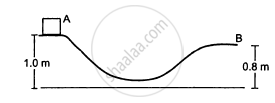Advertisements
Advertisements
प्रश्न
Two spherical bodies, each of mass 50 kg, are placed at a separation of 20 cm. Equal charges are placed on the bodies and it is found that the force of Coulomb repulsion equals the gravitational attraction in magnitude. Find the magnitude of the charge placed on either body.
उत्तर
Mass = 50 kg
Separation between the masses, r = 20 cm = 0.2 m
Let the change on each sphere be q.
Now, gravitational force, \[F_G = G\frac{\text{ m } _1 \text{ m } _2}{r^2}\]
\[= \frac{6.7 \times {10}^{- 11} \times \left( 50 \right)^2}{\left( 0 . 2 \right)^2}\]
\[ = \frac{6.7 \times {10}^{- 11} \times 2500}{0 . 04}\]
\[\text {Coulomb force}, \text {F_c} = \frac{1}{4\pi \in_0}\frac{q_1 q_2}{r^2}\]
\[ = 9 \times {10}^9 \frac{q^2}{0 . 04}\]
Since FG = Fc, we have :
\[\frac{6 . 7 \times {10}^{- 11} \times 2500}{0 . 04} = \frac{9 \times {10}^9 \times q^2}{0 . 04}\]
\[ \Rightarrow q^2 = \frac{6 . 7 \times {10}^{- 11} \times 2500}{9 \times {10}^9}\]
\[ = \frac{9 \times {10}^9}{0 . 04} = 1809 \times {10}^{- 18} \]
\[ \therefore q = \sqrt{18 . 09 \times {10}^{- 18}}\]
\[ = 4 . 3 \times {10}^{- 9} C\]
Thus, the charge of the spherical body is \[4 . 3 \times {10}^{- 9} C\]
APPEARS IN
संबंधित प्रश्न
State if the following statement is true or false. Give a reason for your answer.
Work done in the motion of a body over a closed loop is zero for every force in nature.
When Neils Bohr shook hand with Werner Heisenberg, what kind of force they exerted ?
Let E, G and N represent the magnitudes of electromagnetic gravitational and nuclear forces between two electrons at a given separation. Then
The force with which the earth attracts an object is called the weight of the object. Calculate the weight of the moon from the following data : The universal constant of gravitation G = 6.67 × 11−11 N−m2/kg2, mass of the moon = 7.36 × 1022 kg, mass of the earth = 6 × 1024 kg and the distance between the earth and the moon = 3.8 × 105 km.
The average separation between the proton and the electron in a hydrogen atom in ground state is 5.3 × 10−11 m. (a) Calculate the Coulomb force between them at this separation. (b) When the atom goes into its first excited state the average separation between the proton and the electron increases to four times its value in the ground state. What is the Coulomb force in this state?
The magnetic force on a charged particle is always perpendicular to its velocity. Can the magnetic force change the velocity of the particles? Speed of the particle?
The work done by all the forces (external and internal) on a system equals the change in ______.
A block of mass m slides down a smooth vertical circular track. During the motion, the block is in
A box is pushed through 4.0 m across a floor offering 100 N resistance. How much work is done by the resisting force?
A constant force of 2⋅5 N accelerates a stationary particle of mass 15 g through a displacement of 2⋅5 m. Find the work done and the average power delivered.
A man moves on a straight horizontal road with a block of mass 2 kg in his hand. If he covers a distance of 40 m with an acceleration of 0⋅5 m/s2, find the work done by the man on the block during the motion.
A block of mass 2 kg kept at rest on an inclined plane of inclination 37° is pulled up the plane by applying a constant force of 20 N parallel to the incline. The force acts for one second. Find the work done by the force of gravity in that one second if the work done by the applied force is 40 J.
A block of mass 2 kg kept at rest on an inclined plane of inclination 37° is pulled up the plane by applying a constant force of 20 N parallel to the incline. The force acts for one second. Find the kinetic energy of the block at the instant the force ceases to act. Take g = 10 m/s2.
A uniform chain of mass m and length l overhangs a table with its two third part on the table. Find the work to be done by a person to put the hanging part back on the table.
A block of mass 1 kg is placed at point A of a rough track shown in figure following. If slightly pushed towards right, it stops at point B of the track. Calculate the work done by the frictional force on the block during its transit from A to B.

A body is being raised to a height h from the surface of earth. What is the sign of work done by applied force?
Force acting on a particle is (2`hat"i"` + 3 `hat"j"`) N. Work done by this force is zero, when a particle is moved on the line 3y + kx = 5. Here value of k is ______.
A body is displaced from (0, 0) to (1 m, 1 m) along the path x = y by a force F = (x2`hat"J"` + y`hat"i"`)N. The work done by this force will be:
